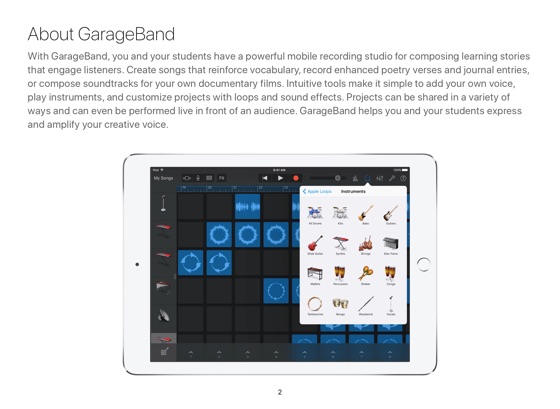GarageBand User Guide for iPad
The Live Loops grid is where you record, play, and edit your musical ideas. The grid consists of cells, which can be empty or filled. Cells can contain Touch Instrument recordings, loops, or audio files. You can start and stop individual cells freely, or start multiple selected cells in sync.

In the grid, cells are arranged in rows and columns. Each row uses the same Touch Instrument, similar to a track in Tracks view, and only one cell in a row can play at a time. Cells in a column can have different lengths (durations). You can play back cells in a column individually, or start playback for all cells in the column simultaneously, using the trigger at the bottom of the column.
Jun 09, 2015 Get your free Garageband Quick Start Guide here. How Does GarageBand For iPad Work Tutorial For Beginners. The Beginner's Guide To Software Defined Radio RTL-SDR - Duration. Extensive Garageband iPad Tutorial Garageband is another unique gift from Apple for audiophiles and more pertinently for music creators or prodigies altogether. IPad further exploits the full functionality of GarageBand by extending the intuitiveness with its overtly simple but responsive touch screen gestures. Jan 10, 2019 Introduction to garageband on iOS using an iPad, Looking at using tracks and live loops as well as understanding the GUI interface. Playing notes an.
Playing cells and other actions in the grid follow the current Time Snap setting. Time Snap ensures that your changes start at musically meaningful points in time (beats or bars), so they are in sync with other cells. You can set the Time Snap value and change it while you are working in the grid.
Set the Time Snap value for the grid
Tap the Time Snap value located in the upper-right corner of the grid, then choose a Time Snap value from the pop-up menu. You can tap the Time Snap value and swipe to choose a value in one motion.
Turn off Time Snap
Zoom the grid in or out
Do one of the following:
Pinch the row headers.
Pinch the column triggers.
When cell editing is turned on, you can pinch directly on the grid to zoom in or out.
Scroll the grid
Show any hidden tracks: Swipe the row headers vertically.
Show a different part of the grid: Swipe the column triggers horizontally.
When cell editing is turned on, you can touch and hold a cell, then swipe horizontally or vertically to show a different part of the grid.
GarageBand User Guide for iPad
The first time you open GarageBand, you see the Sound browser, where you can choose a Touch Instrument to play. There are Touch Instruments for keyboard, guitar, bass, drums, strings, and more, designed to help you make music easily. In the Sound browser you can also open the Sound Library, where you can download additional Touch Instruments, sounds, and loops.
Choose a Touch Instrument
In the Sound browser, swipe left or right to view the instruments, and tap the one you want to play. Tap More Sounds to see additional sounds for that instrument.
The Touch Instrument opens. To choose another instrument, tap the Browser button on the left side of the control bar to return to the Sound browser, then tap a different instrument. You can also touch and hold the Browser button, and choose another instrument from the list.
Each Touch Instrument has a play area and a controls area. You play melodies, chords, and sounds by touching the keys, strings, or other elements in the play area, and change the sound of the instrument using the knobs, buttons, and other controls in the controls area.
Garageband For Ipad Tutorial
At the top of the screen is the control bar, featuring navigation, playback, and volume controls. Below the control bar is a ruler that shows musical time in bars and beats. The playhead moves across the ruler to show what part of the song is currently playing.

After the Touch Instrument opens, you can start playing. The following sections give specific information about each type of Touch Instrument:
Garageband For Ipad Air
You can tap the Live Loops button to start working in the Live Loops grid.
Garageband Ipad Tutorial
You can also tap the Info button in the upper-right corner to show the coaching tips overlays, which contain helpful information about the current instrument or Tracks view. You can play the instrument and use all its controls while the coaching tips are visible. Tap the Info button again to hide the coaching tips.